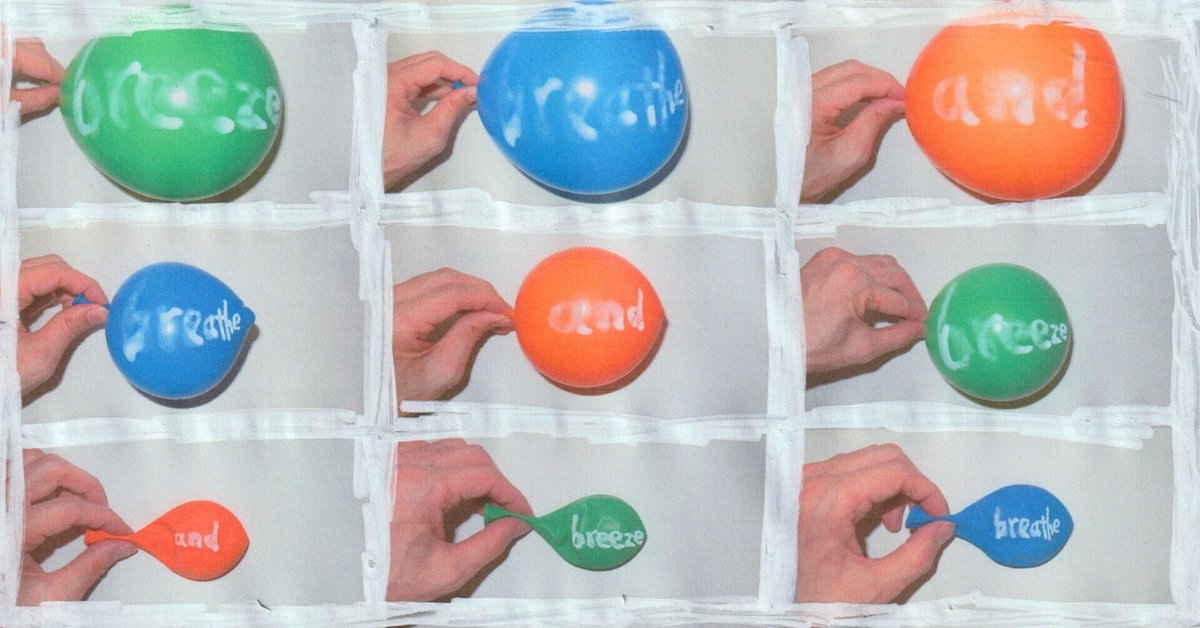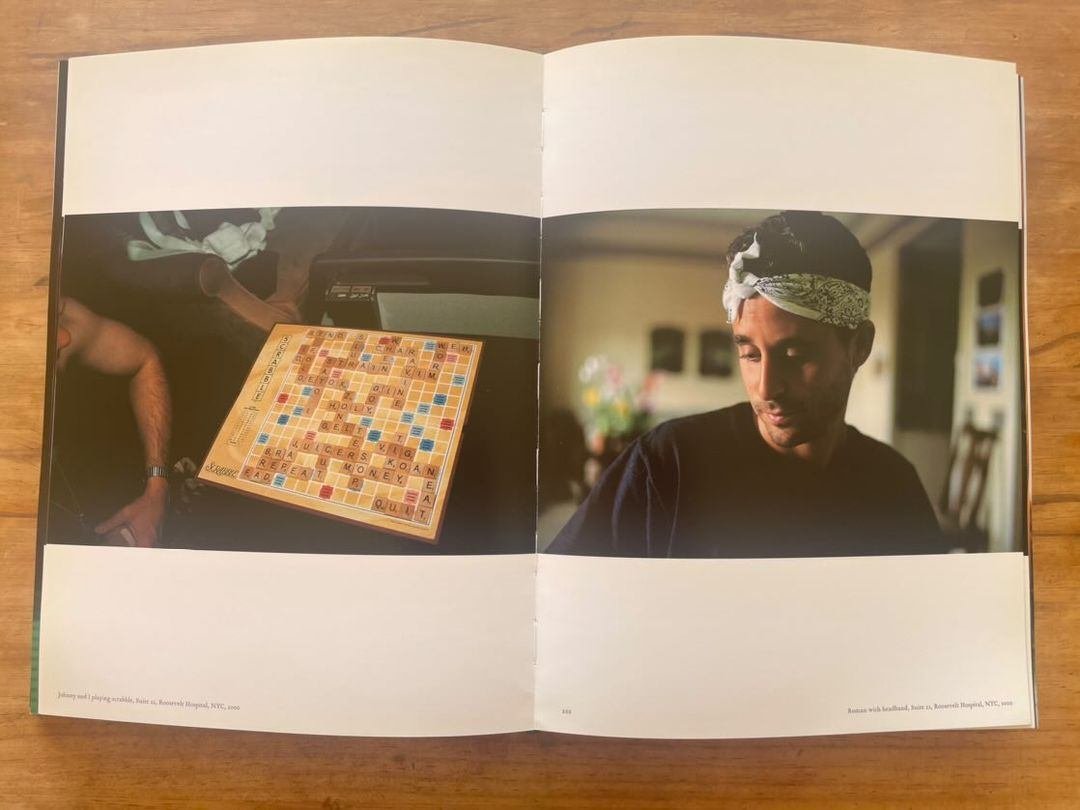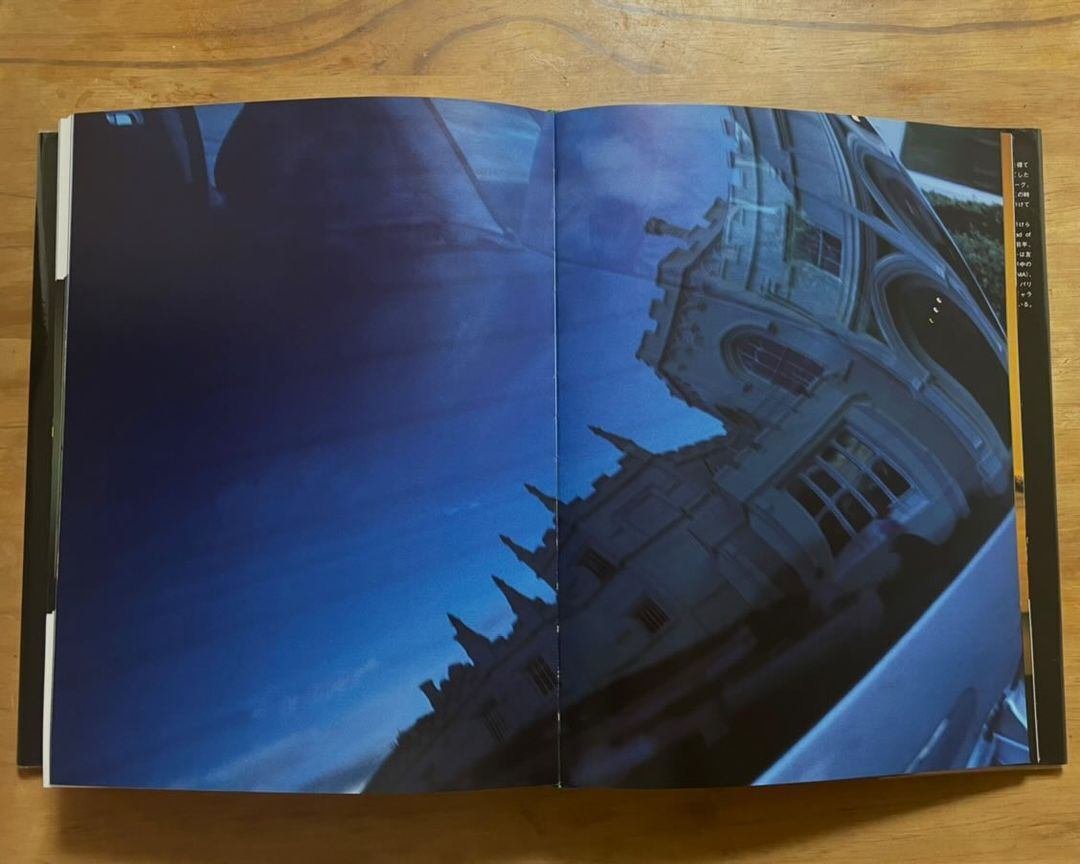
breathe and breeze #1
文:ハセベチカ/Chika Hasebe
Nan Goldin: The Devil's Playground
(English ver. is below)

『The Devil's Playground(悪魔の遊び場)』(2005)は、Nan Goldin(ナン・ゴールディン)の心身の変化の表れを示す記録。
800枚の写真のスライドショーである代表作『The Ballad of Sexual Dependency(性的依存のバラード)』(1985)をはじめ、彼女の写真は一貫して自身の日記であり、現実の延長線上にある。目の前の出来事を忠実に記録するため、被写体には一切ポーズを取らせないし、手を触れることもない。作為を嫌い、事実に従順なのだ。
撮られた写真の一つ一つからは強い眼差しを感じるはずだ。その眼差しは個人を超えて社会に向けられたものである。Goldinは、彼女の日記という私的な直接性を用いて、社会が目を伏せようとするものを力づくで視界に入れさせ、日常を包み隠さず公開してきた。

日記を撮るのは、生い立ちにわけがある。彼女が家を出たのは14歳の時。姉の死をきっかけに崩壊していった家庭を捨てた。15歳でカメラを手に取り、自分の本当の家族には感じられなかった"家族"を、同じように生きる友人や恋人といった近しい存在に重ね合わせて、そんな彼らを撮り続けた。実際、彼女が撮る人物のほとんどは、生活を共にしたことがある人ばかりだという。近しいとは文字通り距離が近い人たちのことだった。だからこそ、カップルのセックスや気怠げな友人の身体がそのまま写せる。被写体に溶け込むようにカメラの前で透明になる彼女だからこその写真だ。そんな彼らの記録を撮ることは、"家族"の思い出であり、無常に対する小さな抗いではないだろうか。

本書では、様々な場所の青が印象的な風景、柔らかな中流階級のカップルや家族の愛情の交換、触れる空気が冷たい病室など、撮る被写体の棘が減った。彼女が常に自分の現在地を記録をしているというのであれば、今の生活はもう過去とは違うのだ。
それは、ドラマチックな個人史やリアリティの追求がどうでも良くなったわけではないが、今はそこまで大きな話をしている場合ではなく、自分や周りの人の生きること自体に集中せざるを得なくなったことが大きい。実際、90年代に入ってから、彼女のコミュニティはAIDとドラッグにより深刻な打撃を受けたことで、生き残りと回復が最優先になった。
ただ、自分の健康自体には悲観していない、もしくは興味がないという方が正しいだろうか。人生で最も影響を与えた幼少期の姉の自殺、若くして命を落としていった"家族"を目の当たりにしてきたことで、淡白な死生観を持っているからかもしれない。

だからこそ心身が変化してからの写真も、絶望感や孤独はなく、あくまで些細な情景の切り取りが連続する。『Psychedelic flowers』(2000)という作品は、病室に花というシーンを、NYの高層ビルに反射する夕焼けの暖かなオレンジが優しく包む。不思議とそこには安らぎすら漂っている。

とはいえ、身の回りに起きる変化に不穏な気配を感じているのは確かだ。NYでの入院生活を綴った本書初公開シリーズ『57days(57日間)』(2000)とロンドンでの入院時の『Cinema Voltaire(シネマ・ヴォルテール)』(2002)シリーズでは、同じ病院生活の記録でも、後者には影が差している。特に『The Priory distorted in reflection』(2002)という作品は、ただ車に映る小修道院にすぎないが、どこか彼女がたびたび見ている幻覚の現れのようにも見える。大きな怪我や思いがけない薬物依存の再発により繰り返される入院に、彼女は終わりの近づきを感じ始めていたのかもしれない。
「誰だってタンスに隠しておきたい写真はあるでしょ?わたしにとってlandscapeはそれなの」とGoldinは語る。それはアイロニーにすぎないが、それでも彼女のポートフォリオに牧歌的な風景写真は不釣り合いだ。彼女の写真はどこまでも素朴さとは無縁だが、それならば、様々な地の風景と風景に溶け込む人物をまとめた『Elements(エレメンツ)』(1995〜2003)を含む初公開のシリーズは、彼女の本当に心の奥底の感情であり、しまっておいた記憶なのではないか。

本書のタイトルと同名の写真は、その『Elements』の中の一枚。ただ、それが決して代表作だからというわけではなくて、恐らくその写真のタイトルが当時の彼女を表すのにも適していたから持ってきたのだろう。彼女の今は、身体の中で息を潜める悪魔の存在を自認し、それが気まぐれにちょっかいを出すことを受け入れるしかない。決して致命的ではないが、静観もできない。

そのことは本書の構成からもわかる。感情の起伏、体調の良し悪しの波を表すかのように、いつものような身近な人の直接的な記録の後に、今までしまっていた穏やかな空気が顔を出す。その後は再び友人や友人とそのパートナーの親密さの投影、その次には物憂げな景色に移っていく。このように過去と今の違いが完全に消化しきれないまま、その変化の波そのものが表れている。そして最後は教会や墓地、骸骨などを撮ったシリーズ『Remains(遺物)』(1996~2001)で終わる。なんとなく全てを受け入れることを暗示しているようにも見えた。
ちなみに、今年9月にはGoldinが立ち上げた活動団体「P.A.I.N(Prescription Addiction Intervention Now)」による、薬物依存の反対運動をメインに描いた彼女のドキュメンタリー『All the Beauty and the Bloodshed』(2022)が公開された。ヴェネチア国際映画祭で金獅子賞を受賞。日本でも近いうちに上映されるかもしれない。

---------------------
The Devil's Playground is a record of Nan Goldin's physical and mental changes.
Her photographs, including her masterpiece "The Ballad of Sexual Dependency" (1985), are consistently her own diary and an extension of her reality. In order to faithfully record what is happening in front of her eyes, she’s never posed her subjects and not even touched them. She is averse to intention and obedient to the facts.
You can feel the strong gaze of the people in each photograph. Goldin has used the private directness of her diary to force the viewer to see what society tries to hide from them, and to reveal their everyday lives.
There is a reason for keeping a diary, because of her early background. She left home when she was 14 years old. At the age of 15, she was introduced to a camera and began photographing "her family", which she had never felt in her own family, by comparing them to her friends and lovers, who were living in the same way as her. In fact, she once shared her life with most of the people she photographed, which means she was literally close to people who sympathized with her. That is why she could capture the sex of couples or friends with languidness as they were. It is because she becomes invisible in front of the camera that she blends in with her subjects that she is able to take these pictures. Recording them is like a memory of "family" and a small protest against impermanence.
In this book, the thorns of the subjects she photographed have been reduced to the striking blue landscapes of various places, tender middle-class couples and families exchanging affection, and a hospital room where the air is cold to the touch. If she is constantly documenting her present location, then her present life is no longer the past.
That is not to say that dramatic personal histories and the pursuit of reality are no longer important, but it is largely because she is now forced to concentrate on the living itself of herself and the people around her, rather than on such big stories. In fact, since the beginning of the 90s, her community has been severely hit by AIDS and drugs, and then survival and recovery have become her top priorities.
However, it would be more accurate to say that she is not pessimistic about it or not even interested in her own health per se. Perhaps it is because she has an indifferent view of life and death, having witnessed the suicide of her older sister when Goldin was a child as the most influential event in her life, and her "family" losing their lives at a young age.
This may be the reason why her photographs taken after her physical and mental changes do not show despair or loneliness, but rather a series of trivial scenes. In "Psychedelic flowers" (2000), the scene of flowers in a hospital room is gently enveloped by the warm orange of the sunset reflected in the skyscrapers of New York City. Strangely enough, there is even a sense of peacefulness in the scene.
Nevertheless, it is clear that there is a sense of disquiet about the changes that are occurring around her. In the first series of this book, "57days" (2000), which describes her hospital stay in New York, and the "Cinema Voltaire" (2002) series, which documents again her hospital stay in London, the latter is overshadowed by the former, even though they document the same hospital stay. In particular, the work "The Priory distorted in reflection" (2002), which is merely a small monastery reflected in a car, seems somehow to be a manifestation of the hallucinations she often had. Perhaps she sensed the end was near after repeated hospitalizations due to serious injuries and an unexpected relapse into drug addiction.
"Everyone has pictures they want to hide in their wardrobe, don't they? That's what landscape is to me," Goldin says. It's ironic, but even so, the idyllic landscapes in her portfolio are out of place. Her photographs are to no great extent unsophisticated, but then, her first public series, including "Elements" (1995-2003), a collection of landscapes from various locations and people blending into the landscape, must truly be her innermost feelings and stored away memories.
The photograph with the same name as the title of this book is one of the photographs in the "Elements" series. However, it is not because it is her masterpiece, but perhaps because the title of the photo was also suitable to describe her at that time. She is now aware of the presence of a demon that lurks in her body, and she has no choice but to accept that it may chomp at her whim. It is by no means fatal, but it is also not static.
This is evident in the structure of this book. After the usual, direct record of familiar people, as if to show the ups and downs of their emotions and the waves of their physical condition, the air of calm that had been tucked away comes to the surface. Then we move again to the projection of the intimacy of friends and their partners, followed by weary scenery. Thus the difference between the past and the present is not fully digested, but the wave of change itself is shown. And finally, it ends with the series "Remains" (1996~2001), in which she photographs the likes of churches, cemeteries, and skeletons. Somehow it seems to imply an acceptance of everything.
Incidentally, this September, the activist organization P.A.I.N. (Prescription Addiction Intervention Now), founded by Goldin, released her documentary "All the Beauty and the Bloodshed" (2022). It won the Golden Lion at the Venice International Film Festival. It may be screened in Japan in the near future.
---------------------
参考文献/Reference
https://www.theguardian.com/artanddesign/2014/mar/23/nan-goldin-photographer-wanted-get-high-early-age
https://youtu.be/rJKe4IZBZIQ
https://youtu.be/Cag_2c0jTS4
https://www.tate.org.uk/art/artworks/goldin-misty-and-jimmy-paulette-in-a-taxi-nyc-p78046
https://www.tate.org.uk/art/artists/nan-goldin-2649/nan-goldin-work-comes-empathy-and-love
執筆者
ハセベチカ
'98年生まれ 早稲田大学法学部卒
日英で文章を書きます
コラムの連載を持ちたいです
街中の人の装いが気になります
website: https://sites.google.com/view/chikahasebe
contact: hasebee.c@gmail.com
IG: @chika__chika__
いいなと思ったら応援しよう!

